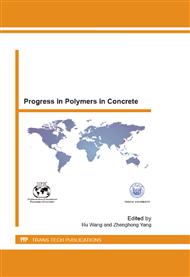[1]
M.R. Labiadh, M.B. Ouezdou, B.T. Hajjem, Characterization of waterproof-covering mortars on Ottoman monuments of "Ghar El Melh", Construction and Building Materials 23 (2009) 423-433.
DOI: 10.1016/j.conbuildmat.2007.11.007
Google Scholar
[2]
S.J.M. Leo, Waterproofing of Portland cement mortars with a specially designed poly-acrylic latex, Cement Concrete Research 3 (25) (1995) 503-509.
DOI: 10.1016/0008-8846(95)00039-f
Google Scholar
[3]
M. Gao, D.F. Lu, S.F. Chen, The study of waterproof dry mortar, Waterproof Materials and Construction 8 (2004) 39-41.
Google Scholar
[4]
Y. Ohama, Handbook of Polymer-Modified Concrete and Mortars Properties and Technology, Noyes Publications, 1995.
Google Scholar
[5]
J.X. Zhang, S.S. Jin, J. Zhang, The study on basic properties of polymer latex modified cement mortar, Journal of Beijing University of Technology 35 (8) (2009) 1062-1068.
Google Scholar
[6]
J. Zhang, L.Wu, Y.H. Li, The performance of the single-component cement based waterproofing slurry containing VINNAPAS⑧redispersible powder, China building waterproofing z1 (2004) 66-70.
Google Scholar
[7]
L.G. Xu, C.J. Wang, The single component latex powder modified cement based waterproofing slurry system, China building waterproofing material 1 (2010) 4-7.
Google Scholar
[8]
R. Wang, P.M. Wang, The effect of the SBR dispersion and SBR powder on the formation of cement hydration products, Journal of the Chinese Ceramic Society 36 (7) (2008) 912-919, 926.
Google Scholar
[9]
R. Wang, P.M. Wang, Formation of hydrates of calcium aluminates in cement pastes with different dosages of SBR powder, Construction and Building Materials 25 (2) (2011) 736-741.
DOI: 10.1016/j.conbuildmat.2010.07.013
Google Scholar
[10]
F.L. DONG, S.G. Ge, R.J. Yang, The influence of poly-cement ratio on the performance of polymer modified cement based waterproof coating, Journal of Yunnan University 24 (1A) (2002) 129-132.
Google Scholar
[11]
J. Schulze, O. Killermann, Long-term performance of re-dispersible powders in mortars, Cement and Concrete Research 31 (2001) 357-362.
DOI: 10.1016/s0008-8846(00)00498-1
Google Scholar
[12]
R. Wang, X.G. Li, P.M. Wang, Influence of polymer on cement hydration in SBR-modified cement pastes, Cement and Concrete Research 36 (9) (2006) 1744-1751.
DOI: 10.1016/j.cemconres.2006.05.020
Google Scholar
[13]
L.S. Pan, Q.Q. Xue, Y.X. Pang, The impact factors of mortar impermeability and compressive strength, Journal of South China University of Technology 33 (7) (2005) 47-50.
Google Scholar
[14]
Y.S. Zhang, C.Y. Xu, Y.H. Yu, The performance of new fiber waterproof powder mortar, Concrete 11 (2007) 69-72.
Google Scholar
[15]
H.X. Xiao, The study of preparation and performance of the dry-mixed and anti-cracking mortar, Chongqing University, Chong Qing, 2007, pp.34-38.
Google Scholar
[16]
P.M. Wang, Q. XU, J.Stark, The physical performance of HEMC cement mortar added slag powder and Superplasticiser, Journal of Building Materials 4 (2) (2001) 122-126.
Google Scholar
[17]
L.L Xue, Q.F. Zhong, H.F. Liu, The influence of inorganic fillers on the performance of polymer waterproof mortar, China Concrete and Cement Products 1 (2011) 59-62.
Google Scholar
[18]
E.H. Hwang, Y.S. Ko., Comparison of mechanical and physical properties of SBR-polymer modified mortars using recycled waste materials. Ind. Eng. Chem. 14 (2008) 644-650.
DOI: 10.1016/j.jiec.2008.02.009
Google Scholar
[19]
Y.B. Sun, Z. Li, Chen Pan. The study of admixtures on impermeability of mortar, China Rural Water and Hydropower 11 (2009) 122-124.
Google Scholar
[20]
F.Q. Zhao, H. Li, S.J. Liu, Preparation and properties of an environment friendly polymer-modified waterproof mortar, Construction and Building Materials 25 (2011) 2635-2638
DOI: 10.1016/j.conbuildmat.2010.12.012
Google Scholar
[21]
Y.C. Chen, N.H. Peng, J. Wan, The study of fly ash-based dry powder waterproof mortar, Journal of Minerals zl (2010) 134-135.
Google Scholar
[22]
H.D. Xie, Y.F. Zhang, Q.W. Dong, The experimental study of impermeability performance of artificial sand dry mix ordinary waterproof mortar, New Building Materials 10 (2010) 66-69.
Google Scholar
[23]
J. Wang, Q.S. Li, The shrinkage cracking performance of the rubber mortar, Journal of Building Materials, 10 (1) (2007) 97-100.
Google Scholar


